I have recently started reading the internet editions of Sindhi newspapers and I find the standard of journalism there at par, if not better than Urdu and English. While Urdu and English media gets all the attention, Sindhi press is lesser recognized.
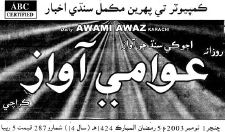
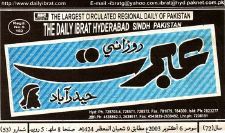
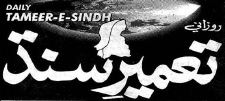
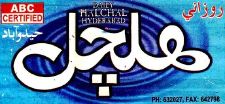
Sindhi newspapers cover all those items that one finds in national newspapers. Besides ‘aham khabrooN’ (important news), ‘wadheek khabrooN’ (more news) we can find business news, Showbiz, Sports, Editorials, cartoons, feature articles etc all in Sindhi newspapers. One obvious contrast between Urdu, English versus Sindhi newspapers however, is the news prioritization. Sometimes the headlines on Sindhi newspapers find a small place on back page of national dailies and vice versa.
On Irrigation Water Issues
One topic which I have consistently found appearing in bold in Sindhi newspapers is about the irrigation water. While Urdu press does not mention irrigation issues unless there is a flood or severe drought, water flow measurements at Sindh barrages make regular appearence in Sindhi news. Every few days I see a news item showing concern on depleting water levels at Guddu, Sukkur and desert like conditions downstream of Kotri. It shows that sharing of river water is a matter much more serious for Sindh than it gets its share on national media. This issue gets such a unanimous support in Sindhi press that I have not yet seen a single editorial in support of building new dams like Kalabagh etc. My guess is that in coming years, water sharing will become a major problem among provinces.
Who reads Sindhi Newspapers?
I believe the newspapers are alive and thriving because Sindhi is loved by the people who speak it and they prefer to get their news in Sindhi. Then there is another group of people whose mother tongue is not Sindhi but they like to read Sindhi newspapers in order to understand the regional perspective. I belong to this second group of people.
Sindhi newspapers also cater to the strong currents of Sindhi nationalism present in Sindh province.
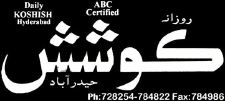
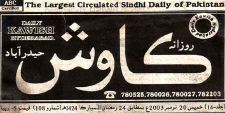

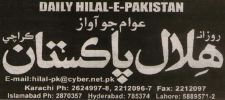
The Sindh-Punjab Equation
Another thing which I have noticed in Sindhi newspaper is their stress on the Sindh-Punjab comparison. It is not a secret that smaller provinces feel that they have to compete with the larger province in every social and economic field to maintain their historical and current provincial identity. This feeling is reflected in provincial newspapers also where almost all Sindhi newspapers try to dwelve on Sindh-Punjab comparison or try to show the picture where smaller provinces are not being treated fairly.
There is a strong need of bringing Sindhi and other provincial issues at National level to build consensus on them which in turn will strengthen national harmony. Currently many hot issues brew up and remain hidden from people in larger cities because Urdu and English media does not cover them as well as Sindhi newspapers do. Translating important news from Sindhi to Urdu/English and getting them prime real state on National dailies is the need of the hour. Here I must mention that the daily Dawn does give a weekly review of Sindhi newspapers in its features section.
Current State of Sindhi Press
More than fifteen daily Sindhi newspapers are published in Pakistan with Hyderabad being the largest center of such publications. Karachi and Sukkur follow suit. Largest circulation belongs to Kawish.
Ibrat newspaper has a leaning or a soft corner towards Pakistan Peoples Party. It is circulated more among politically conscious readership. Kawish on the other hand is more of an awami(public) newspaper and has a larger circulation. Kawaish has recently ventured into TV media also and KTV channel belongs to them.
Brief History of Sindhi Press
 The pioneers of journalism in Sindh were the Persian language newspapers. First Persian language newspaper started in Sindh in 1855. Its owner was Mirza Mukhlis Ali. In 1860, Mirza Mukhlis started a bilingual newspaper from Sukkur which printed one column in Persian and the other column contained its Sindhi translation. This newspaper was called ‘Matla Khursheed’ and is considered as the first Sindhi newspaper of the subcontinent. Matla Khursheed continued to publish until 1910.
The pioneers of journalism in Sindh were the Persian language newspapers. First Persian language newspaper started in Sindh in 1855. Its owner was Mirza Mukhlis Ali. In 1860, Mirza Mukhlis started a bilingual newspaper from Sukkur which printed one column in Persian and the other column contained its Sindhi translation. This newspaper was called ‘Matla Khursheed’ and is considered as the first Sindhi newspaper of the subcontinent. Matla Khursheed continued to publish until 1910.
The first Sindhi only newspaper was called ‘Moin-ul-Islam’ and it started its circulation in 1880. This was followed by various other papers such as Sind Sudhar, Muawan Majma, Saraswati, Aftab Sind, Kher Khoah, Musafir and Al Haq
The second period of Sindhi Journalism began with the publication of Al Hilal in 1901. The first Sindhi daily called Sind Wasi came out in 1908 and the second Hind Wasi in 1917. During this period a number of important papers were brought out which included Al Kashif, Al Ameen, Tauheed, Sitara-e-Sind and Subah Sind. This period culminated with publication of Al Waheed, the greatest Sindhi newspaper to date which was not only a newspaper but a movement and played a leading role in the establishment of Pakistan. Sheikh Abdul Majid Sindhi, Maulana Din Mohammad Wafai, Prof. Din Mohammad Alig, Pir Ali Mohammad Rashidi and Kazi Abdur Rehman were some of the stalwarts of journalism at the time who with their pens raised the consciousness of the people and made them aware of their rights.
Hilal-e-Pakistan began publication in 1946 at Hyderabad. It also mobilized people in favor of Pakistan. Hilal-e-Pakistan is probably the only Sindhi newspaper which has offices in Islamabad and Lahore also.
After independence of Pakistan several new papers came into existence, including Naeen Sind, Mehran, Azad, Nawai Sind.
List of current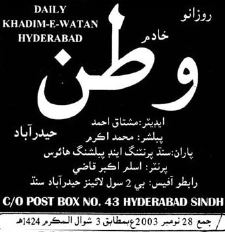 Sindhi Newspapers
Sindhi Newspapers
- Kawish, Hyderabad
- Ibrat, Hyderabad
- Hilal-e-Pakistan, Hyderabad
- Khadim-e-Watan
- Mehran, Hyderabad
- Awami Awaz, Karachi
- Nai Zindagi
- Parish
- Udhar
- Gulful
- Halar
- Sham
- Koshish
- Tameer-e-Sindh
- Halchal
- The Daily Nijat: Sukkur, Karachi
Reference:
(1) Material for “Brief History of Sindhi Newspapers” has been taken from an article “Sindhi Press in Pakistan” written by Shahida Mirza
(2) ‘aaj ka Sindh’ by Mahmood Mirza.




















































Last week’s Sindhi newspaper recap by Dawn:
http://www.dawn.com/2007/04/12/fea.htm#1
Anwar: Punjab is very unlike the other parts of Pakistan. Punjab is where two-thirds of the Pakistanis live. Punjab is where every one comes to for one reason or the other and settles down and their next generation becomes “Punjabi”. That is the beauty of Punjab. At the same time Punjabis, both old and new, have little problem adopting Urdu as their language no matter in what form. There are many internal and external dynamics at work here. No need to fight the hands of the clock. Let every one keep and speak what ever language they wish. But in case of Punjab expose students to the other regional languages as well. Sooner or later one common Pakistani language will emerge. Call it ‘Lingua-Franca’. Call it ‘Pakistani’. Call it what may. But people from one part of the country must be able to communicate with people from other parts of the country. People who are able to communicate with each other are able to better understand each other.
Good suggestion Peraiz. I grew up reading “Nakoosh” and “Lail-o-Nehar”, and in the early days “Urdu Digest” but now to read Urdu I have to pull out old poetry and prose books from my study. Few years ago I gave up reading modern “new age” Urdu altogether as my vacabulary did not include reading English trnasliterated in Urdu. While Urdu culture from across the border has overwhelmed the country, Urdu as a language has lost grounds to English – much like Piggen spoken in Papua New Guinea. This is typical of weak or artificial languages that do not have strong traditional and historic foundations.
Regarding your observations of Urdu in Punjab,I must add tht Punjab has traditionally served the power in place. It is interesting to note that persian, even after a strong presence of Mughals, did not take root but Urdu caught up as Punjabi elite realized who the power brokers were in new setting. Furthermore, in Pakistan, a “danishwer” was supposed to be “Ahl-e-zuban,” a race for elite status many in Punjab got into while the rest of the provinces retained their pride in original languages.
What is interesting is that in the households of my Pathan friends I always hear Pushto, my Sindhi friends always communicate in Sindhi, Persian friends speak pure persian, so do Arabs , but my friends from Punjab encourage their children to speak Urdu only – and the kids speak adulterated Urdu and no Punjabi.Even my Afghani in-laws settled in Lahore for generations communicate in Persian. This shows how anchored people are in strong languages rooted in history.
Therefore to push for Urdu as a savior language may not be useful. It was a “Lashkari Zuban” brought into existance by circustances of time. If Qaid-e-Azam had taken advice of Sir Agha Khan and had declared Arabic as a national language, we may have had a united country and perhaps no bloodshed of 1971, and later in Sindh. Being a language of the faith, Arabic would have produced a cohesive Pakistan. Something that Urdu will never be able to deliver. But it is too late. Let us enjoy for what is left.
Anwar: While other regions are sensitive on the subject of language, Punjab in general, since the arrival of Islam and Muslims, has not used Punjabi as a medium of instructions; it has always been the Arabic, Persian, English and Urdu. As a result while the ‘schooled punjabis’ along with Punjabi use Urdu and English as a way of communication, the ‘unschooled punjabis’ can only communicate in their native tongue. Now if rest of the country adopts Urdu and English as mediums of instruction and ‘schooling’ is made mandatory then all of its population will be able to communicate with each other and soon the country will have its own ‘Lingua Franca’ which I call “Pakistani Urdu Language”. In the absence of that I propose that grade 9 to 12 students in Punjab be exposed to the major regional languages of the country so that at least two-third of Pakistanis have the minimum level of some understanding of the regional languages of the country. The bottom line is education. Each and every child in Pakistan must be ‘schooled’.
I had only a superficial familiarity of the problems of Sindh until a Sindhi became part of our family about 20 years ago. First hand knowledge I gleaned from him gave me a better understanding of what Sindh has been all about. My association with other friends rooted in Sindh has also been very fruitful.
Sindh is indeed a land of intellectuals in par with Bengal. It was a delight to see the vibrancey of Sindy press.
While I agree with Pervaiz Alvi that regional languages be taught as required courses in the country, I am not sure it will work well in Punjab – afterall Punjab was first to embrace Urdu with open arms..